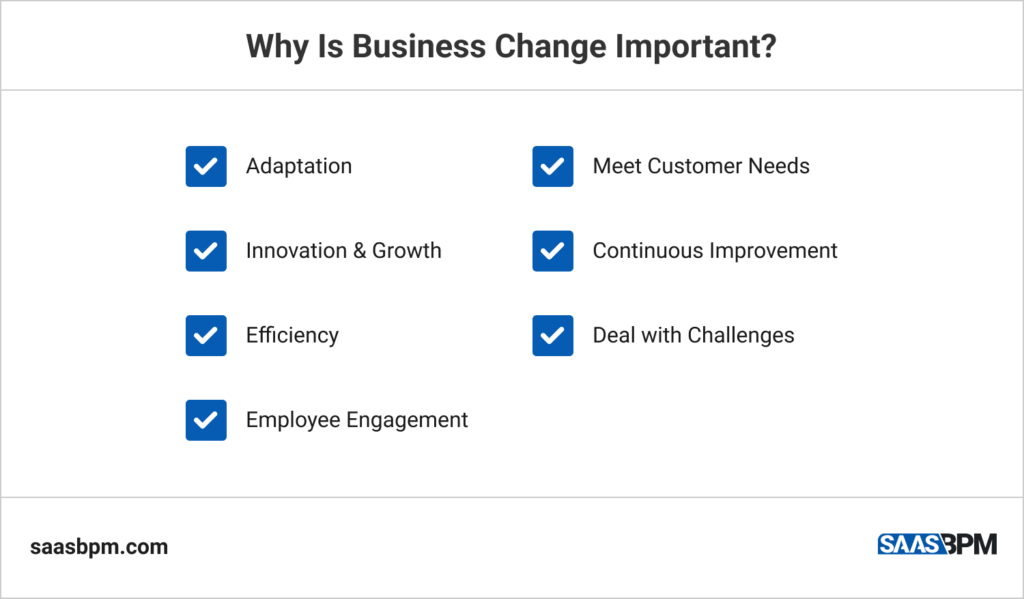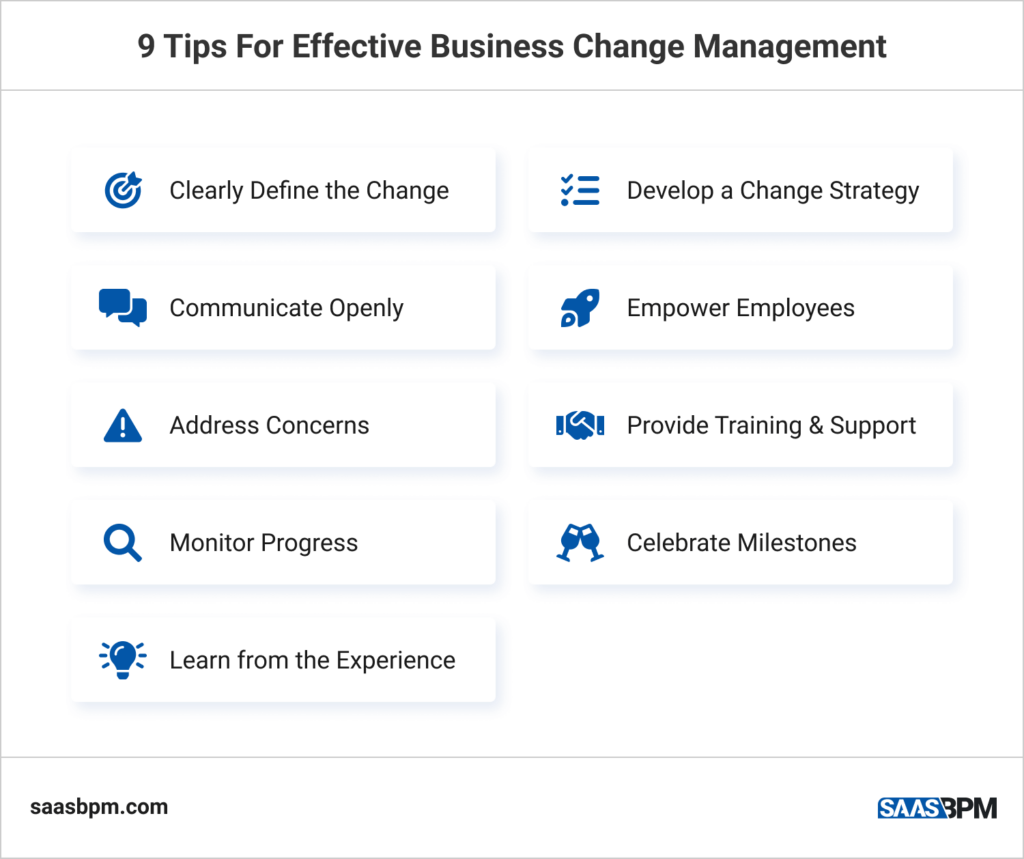In today’s fast-moving world, any business that wants to slow down is set for disappointment, and, in the worst case scenario, for loss of profit and of competitive advantage. Business change and innovation is part of the game to stay ahead of the other players in your niche, so you need to be a part of the change, not just a follower.
In order to make sure your team stays aligned with updates, the best way to go about it is to use a business process management system such as SaaS BPM. In fact, 70% of companies recognize using tech for simplifying manual operations to reduce costs as a top priority. This tool will automate mundane tasks like data entry, time tracking, notifications and progress tracking and let you focus on strategizing for your business through reliable collaboration and communication.
In this article, we will define business change, explain why it is important, and suggest 9 tips to implement it successfully.
What Is Business Change?
Business change refers to the intentional and structured process of making significant alterations to various aspects of a company in order to improve its performance, adapt to new circumstances, and achieve strategic objectives. It involves implementing modifications to the organization’s strategies, processes, technologies, structures, or culture with the aim of enhancing efficiency, profitability, competitiveness, or customer satisfaction.
There are different forms of business change depending on the specific goals and context of the organization. It may involve implementing new technologies, restructuring departments or teams, revising business processes, launching new products or services, adopting new marketing strategies, or even undergoing a complete business transformation.
The need for business change can arise from a variety of factors, including shifts in market conditions, advances in technology, changes in customer preferences, regulatory requirements, or internal issues such as inefficiencies, outdated systems, or declining performance.
Managing business change effectively requires a systematic and well-planned approach. It involves analyzing the current state of the business and identifying areas that require improvement or transformation. Also, setting clear goals and objectives, developing a comprehensive change strategy, and engaging and communicating with stakeholders throughout the process are also parts of the picture.
Implementing business change can be a complex and challenging endeavor. It often involves overcoming resistance to change, managing potential disruptions across operations, and ensuring that employees are adequately trained and supported during the transition.
Effective change management practices, including clear communication, stakeholder engagement, and providing support and resources to employees, are essential for successful business change implementation.
By embracing and effectively managing business change, organizations can adapt to evolving market dynamics, stay ahead of competition, improve operational efficiency, enhance customer satisfaction, and achieve long-term growth and success.
Why Is Change Important In An Organization?

Change is an essential and inevitable aspect of organizational growth and success. Embracing and effectively managing business transformation within an organization can yield numerous benefits and contribute to its long-term sustainability. Here are key reasons why business change is important:
Adaptation to a Changing Environment
The business landscape is constantly evolving, driven by technological advancements, market shifts, and customer preferences. Organizations must adapt to these changes to remain relevant and competitive. Embracing change enables organizations to respond to external forces, seize new opportunities, and stay ahead of the curve.
Innovation and Growth
Change often leads to innovation, as it encourages new ideas, approaches, and technologies. By fostering a culture of change, organizations promote creativity and drive innovation, enabling them to develop new products, services, and processes. Embracing change is crucial for fostering growth and expanding into new markets.
Increased Efficiency
Business change initiatives often aim to optimize processes, streamline operations, and improve efficiency. By implementing steps that eliminate redundancies, simplify workflows, and leverage technology, organizations can enhance productivity, reduce costs, and improve overall performance.
Enhancing Employee Engagement and Satisfaction
Change can positively impact employees by providing new challenges, learning opportunities, and career advancement prospects. Involving employees in the change process through effective communication, training, and participation can boost engagement and morale. It shows that their contributions are valued and provides a sense of shared purpose.
Adapting to Customer Needs
Customer preferences and expectations evolve over time. Organizations that adapt and align their products, services, and processes with changing customer needs can gain a competitive edge. Change enables organizations to better understand and meet customer demands, improving customer satisfaction and loyalty.
Continuous Improvement
Change is closely linked to the concept of continuous improvement. By embracing change, organizations foster a culture of learning, adaptability, and agility. They actively seek opportunities to improve and refine their operations, products, and services, ensuring they remain at the forefront of their industry.
Dealing with Challenges and Uncertainty
Change often accompanies challenges and uncertainty. By cultivating a mindset that embraces change, organizations become more resilient and better equipped to navigate through turbulent times. They can proactively respond to crises, market fluctuations, or unexpected events, minimizing potential disruptions.
9 Tips For Effective Business Change Management
Implementing change within an organization can be a complex process that requires careful planning, clear communication, and execution. Here are several tips to ensure effective business change management:

1. Clearly Define the Change
Start by clearly defining the purpose and scope of the change. Clearly communicate the desired outcomes, objectives, and benefits to all stakeholders. A well-defined change plan provides a roadmap and helps manage expectations.
2. Develop a Comprehensive Change Strategy
Craft a comprehensive change strategy that outlines the steps, timeline, and resources required for successful implementation. Break the change into manageable phases and set realistic milestones. Assign responsibilities and establish clear lines of communication.
3. Communicate Openly and Frequently
Communication is vital throughout the change process. Provide regular updates to employees, customers, and other stakeholders to keep them informed and address any concerns. Encourage open dialogue and create opportunities for feedback and input.
4. Involve and Empower Employees
Involve employees in the change process to foster engagement and ownership. Communicate the reasons behind the change and how it aligns with the organization’s goals. Empower employees by providing training, resources, and support to navigate the transition effectively.
5. Address Resistance and Concerns
Resistance to business change is natural. Anticipate it early on and proactively address concerns. Engage with employees to understand their apprehensions and provide clear explanations of the benefits and rationale behind the change. Encourage a culture of open dialogue and offer support to help employees adapt.
6. Provide Training and Support
Equip employees with the necessary skills and knowledge to navigate the change successfully. Offer training programs, workshops, and coaching to help employees understand and embrace the new processes or technologies. Provide ongoing support during the transition period.
7. Monitor and Evaluate Progress
Establish key performance indicators (KPIs) to measure the progress and impact of the change. Regularly monitor and evaluate the effectiveness of the change implementation. Use data and feedback to identify areas that require adjustment.
8. Celebrate Milestones and Successes

Acknowledge and celebrate milestones and successes throughout the change process. Recognize and appreciate the efforts and contributions of individuals and teams involved. Celebrating achievements fosters a positive atmosphere and motivates employees to continue embracing the change.
9. Learn from the Experience
After implementing the change, take the time to evaluate the entire process. Identify lessons learned and areas for improvement. Use this valuable feedback to enhance future change initiatives and continuously improve change management practices within your business.
Bottom Line
Business change is not comfortable. You have to plan all the necessary steps in order to ease your team and all stakeholders involved through the transformation. However, without innovation, organizations will fall behind their competitors and may even stop operation.

